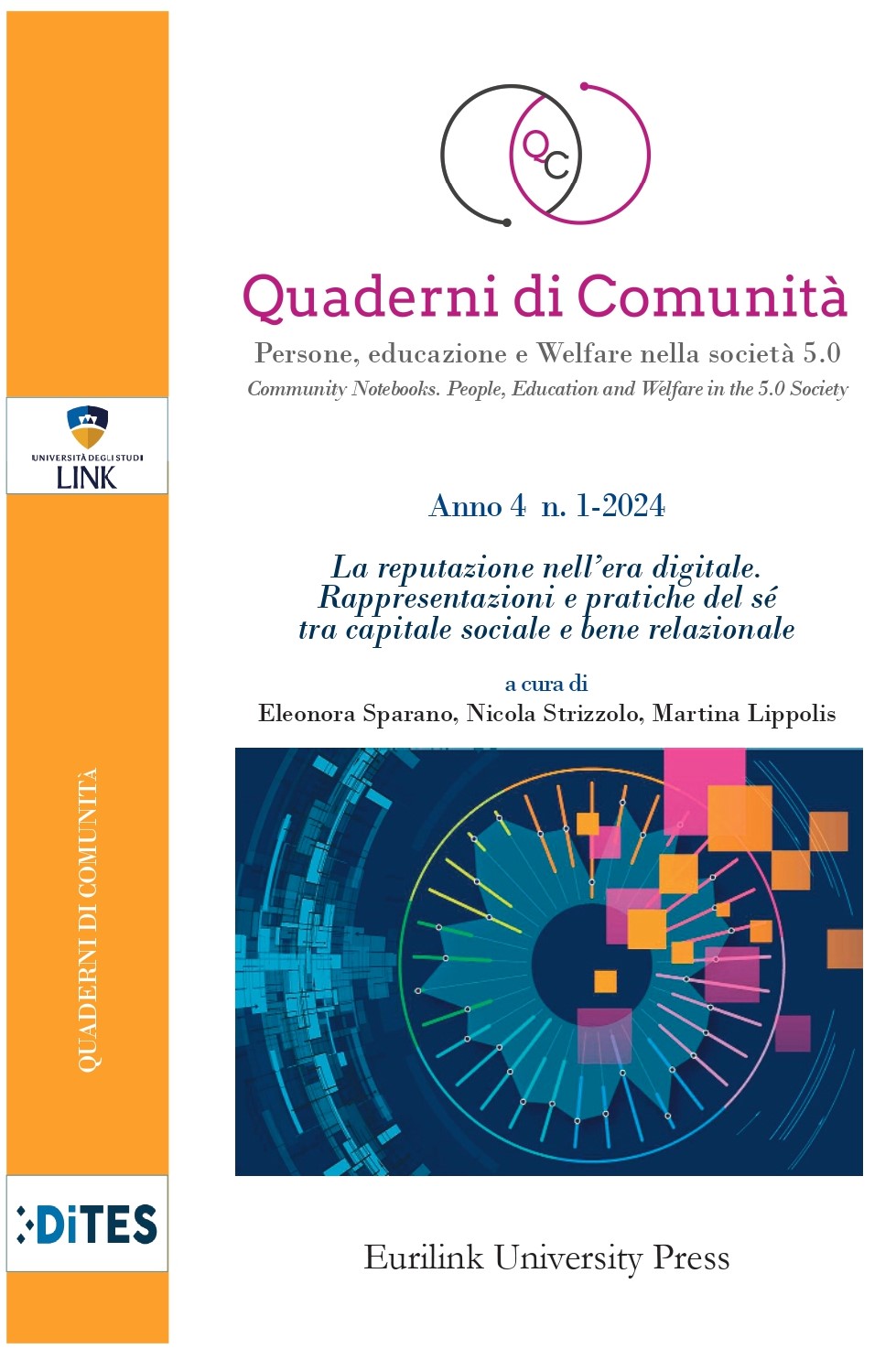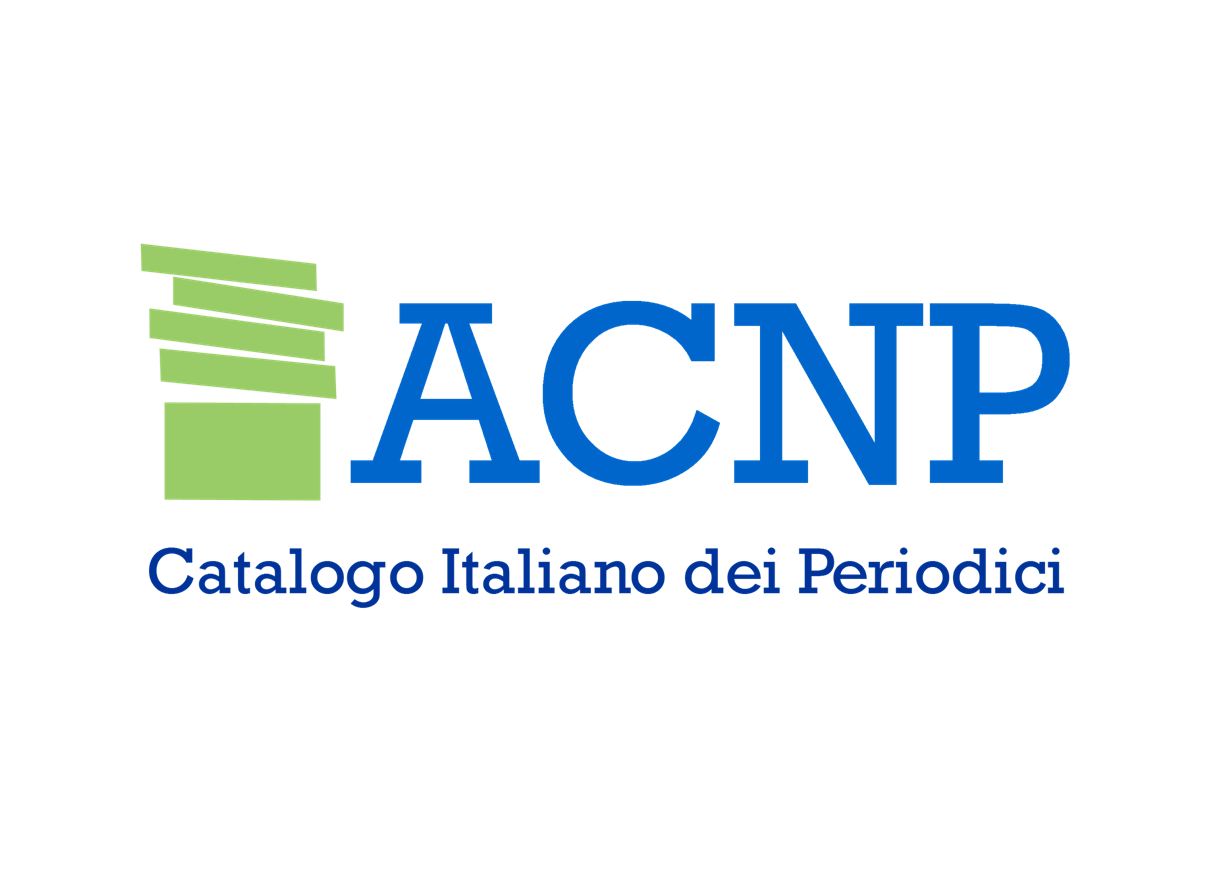La rappresentazione nell'era digitale tra reputazione online e fake challenge
DOI:
https://doi.org/10.61007/QdC.2024.1.258Parole chiave:
era digitale, reputazione online, rappresentazione mediale, fake news, social media challengeAbstract
La proposta analizza la relazione tra fake news e social media challenge. Attraverso lo strumento metodologico dell analisi del contenuto dei casi studio Jonathan Galindo, Momo Game e Blue Whale Challenge (Yin, 2018) si ricostruirà l evoluzione del fenomeno nel rapporto tra notiziabilità e fake news, mostrando come il sistema dell' informazione cerchi di "modellare il discorso pubblico" attorno alle sfide giovanili online, offrendo corto-circuiti tra realtà e immaginazione (Bennato, 2018).
Riferimenti bibliografici
Ahmed, H. (2017), Detecting opinion spam and fake news using n- gram analysis and semantic similarity, Ph.D. thesis.
Agcom (2018). News vs fake nel sistema dell’informazione. Interim report indagine conoscitiva del. 309/16/CONS. Consulted by https://www.agcom.it/documentazione.
Allcott, H. & Gentzkow, M. (2017), Social Media and Fake News in the 2016 Election, in “Journal of Economic Perspectives”, 31, 2, 211-36. DOI 10.1257/jep.31.2.211.
AFSP, American Foundation for Suicide Prevention (2016). Recommendations for reporting on suicide. Consulted by https://afsp.org/reporting-on-suicide-prevention/.
Bada, M. & Clayton, R. (2019), «Online Suicide Games: A Form of Digital Self-harm or A Myth?», in B. Wiederhold, G. Riva & S. Debb (eds.), Annual Review of Cybertherapy and Telemedicine (ARCTT), International Association of CyberPsychology, Training, and Rehabilitation (iACToR), 1-7.
Bakir, V. & McStay, A. (2018), Fake News and the Economy of Emotions: Problems, Causes, Solutions, in “Digital Journalism”, 6, 2, 154-175. DOI 10.1080/21670811.2017.1345645.
Banerjee, R., Feng, S., Kang, J. S. & Choi, Y. (2014), Keystroke patterns as prosody in digital writings: A case study with deceptive reviews and essays, in “Proceedings of the 2014 conference on empirical methods in natural language processing (EMNLP)”, 1469– 1473. DOI 10.3115/v1/D14-1155.
Balmas, M. (2014), When Fake News Becomes Real: Combined Exposure to Multiple News Sources and Political Attitudes of Inefficacy, Alienation, and Cynicism, in “Communication Research”, 41, 3, 430-454. DOI 10.1177/0093650212453600.
Bennato, D. (2018), L’emergere della disinformazione come processo socio-computazionale. Il caso Blue Whale, in “Problemi dell’informazione”, 3, 394-419.DOI 10.1445/91659.
Bode L. & Vraga, E. K. (2018), See Something, Say Something: Correction of Global Health Misinformation on Social Media, in “Health Communication”, 33, 9, 1131-1140. DOI 10.1080/10410236.2017.1331312.
Burgess, A., Miller, V. & Moore, S. (2018), Prestige, Performance and Social Pressure in Viral Challenge Memes: Neknomination, the Ice- Bucket Challenge and SmearForSmear as Imitative Encounters, in “Sociology”, 52, 5, 1035–1051. DOI 10.1177/0038038516680312.
EC (2018b). Communication - Tackling online disinformation: a European approach. European Commission. Consulted by https://digital-strategy.ec.europa.eu.
Cohen, S. (1972), Folk Devils and Moral Panics, London, MacGibbon and Kee Ltd.
Conroy, N. J., Rubin, V. L. & Chen, Y. (2015), Automatic deception detection: Methods for finding fake news, in “Proceedings of the Association for Information Science and Technology”, 52, 1, 1-4. DOI 10.1002/pra2.2015.145052010082.
Dalla Casa, S. (2020), Jonathan Galindo è la nuova Blue Whale: perché continuiamo a cascarci?, in “Wired”. Consulted by https://www.wired.it/internet/web/2020/10/17.
Dentith, M. R. X. (2018), What is fake news?, in “University of Bucharest Review”, 2, 24-34.
Di Franco, G. (2011), Tecniche e modelli di analisi multivariata, Milano, Franco Angeli.
Freud, S. (1919), «Das Unheimliche», in Imago, 5 (trad. it. di Saggi sull’arte, la letteratura, il linguaggio, Torino, Bollati Boringhieri, 1991).
Giaccardi C. (1993), Media, significato e realtà sociale: per un approccio comparativo all’analisi dei testi pubblicitari, in “Studi di Sociologia”, 31, 3, 283-297. Consulted by http://www.jstor.org/stable/23004368.
Giordano, G. (2020), Cosa sappiamo su Jonathan Galindo e la sua presunta sfida online. Consulted by https://www.valigiablu.it/jonathan-galindo-sfida-online/.
Guess, A., Nyhan, B. & Reifler, J. (2018), Selective Exposure to Misinformation: Evidence from the Consumption of Fake News during the 2016 U.S. Presidential Campaign, European Reserach Council. Consulted by http://www.ask-force.org/web/Fundamentalists.
Harcup, T. & O’neill D. (2017), What is News? News Values Revisited (again), in “Journalism Studies”, 18, 12, 1470-1488. DOI 10.1080/1461670X.2016.1150193.
Horne, B. D. & Adali, S. (2017), This just in: Fake news packs a lot in title, uses simpler, repetitive content in text body, more similar to satire than real news, in “ArXiv e prints”. DOI 10.48550/ arXiv.1703.09398.
Hu, L., Wei, S., Zhao, Z. & Wu, B. (2022), Deep learning for fake news detection: A comprehensive survey, in “AI Open”, 3, 133-155. DOI 10.1016/j.aiopen.2022.09.001.
Hung-Yi, L. (2008), Sensation-seeking, Internet dependency, and online interpersonal deception, in “Cyberpsychology Behavior”, 11, 2, 227-231. DOI 10.1089/cpb.2007.0053.
Jack, C. (2017), Lexicon of lies: Terms for problematic information, Data & Society Publication. Consulted by https://datasociety.net/library/lexicon-of-lies/.
Khasawneh, A., Madathil, K. C., Zinzow, H., Wisniewski, P., Ponathil, A., Rogers, H., Agnisarman, S., Roth, R. & Narasimhan, M. (2021), An Investigation of the Portrayal of Social Media Challenges on YouTube and Twitter, in “ACM Transactions on Social Computing”, 4, 1, 1–23. DOI 10.1145/3444961.
Kobilke, L. & Markiewitz, A. (2021), The Momo Challenge: Measuring the Extent to Which YouTube Portrays Harmful and Helpful Depictions of a Suicide Game, in “SN Social Science”, 86, 1, 1-30. DOI 10.1007/s43545-021-00065-1.
Lanius, D. & Jaster, R. (2018), What is fake news?, in “Versus”, 2, 127, 207-224. DOI 10.14649/91352.
Lincos, S. (2020), Quel che c’è da sapere su Jonathan Galindo. Queryonline. Consulted by https://www.queryonline.it/2020/07/10.
Lucarelli, S. (2017), Blue Whale, parla Matteo Viviani de Le Iene: «Sì, i video russi sono falsi ma il pericolo c’è, Consulted by https://www.ilfattoquotidiano.it/in-eicola/articoli.
Lupariello, F., Curti, S. M., Coppo, E., Racalbuto S. S. & Di Vella, G. (2018), Self-harm Risk Among Adolescents and the Phenomenon of the “Blue Whale Challenge”: Case Series and Review of the Literature, in “Journal of Forensic Sciences”, 64, 2, 638-642. DOI 10.1111/1556-4029.13880.
Magid, L. (2018), Dire warnings about children dying because of apps and games are a form of ‘juvenoia’. Parenting for a Digital Future. Blog Entry. Consulted by http://eprints.lse.ac.uk/91815/.
McCombs, M. & Reynolds, A. (2002), «News Influence on Our Pictures of the World», in J. Brynt & D. Zillmann (eds.), Media Effects: Advances in Theory and Research, Lawrence Erlbaum Associates Publishers, Mahwah, 1-18.
Morrongiello, B. A., McArthur , B. A., Kane, A. & Fleury, R. (2013). Only Kids Who Are Fools Would Do That!: Peer Social Norms Influence Children’s Risk-Taking Decisions, in “Journal of Pediatric Psychology”, 38, 7, 744-755. DOI 10.1093/jpepsy/jst019.
Mukhra, R., Baryah, N., Krishan, K. & Kanchan, T. (2019), ‘Blue Whale Challenge’: A Game or Crime?, in Science and Engineering Ethics, 25, 1, 285–291. DOI 10.1007/s11948-017-0004-2.
Nielsen, R. K. & Graves, L. (2017), News you don’t believe: Audience perspectives on fake news, in “Factsheet”, 1-8. Consulted by https://reutersinstitute.politics.ox.ac.uk.
Olteanu, A., Kıcıman, E., & Castillo, C. (2018), A critical review of online social data: Biases, methodological pitfalls, and ethical boundaries, in “Proceedings of the eleventh ACM international conference on web search and data mining”, 785–786. DOI 10.1145/3159652.3162004.
Osgood, C. E. (1956), Behavior Theory and The Social Sciences, in “Behavioral Science”, 1, 1, 167-185. DOI 10.1002/bs.3830010302 Paulussen, S. & Harder, R. A. (2014), Social Media References in Newspapers, in “Journalism Practice”, 8, 5, 542-551. DOI 10.1080/17512786.2014.894327.
Pennycook, G., Cannon, T. D. & Rand, D. G. (2018), Prior Exposure Increases Perceived Accuracy of Fake News, in “Journal of Experimental Psychology: General”, 147, 12, 1865-1880. DOI 10.1037/xge0000465.
Shu, K., Wang, S., Tang, J., Zafarani, R. & Liu, H. (2017), User identity linkage across online social networks: A review, in “ACM SIGKDD Explorations Newsletter”, 18, 2, 5-17. DOI 10.1145/3068777.3068781.
Soukup, C. (2006), Computer-mediated communication as a virtual third place: Building Oldenburg’s Great Good Places on the World- Wide Web, in “New Media & Society”, 8, 3, 421-40. DOI 10.1177/1461444806061953.
Panarese, P. (eds.) (2023), Social media challenge. Processi, attori e rappresentazioni delle sfide virali negli ambienti digitali, Milano, Franco Angeli.
Safenet.bg (2018). The ‘suicidal’ online games and the media carelessness. Consulted by https://www.safenet.bg/en/category.
Tandoc, E., Lim, Z. W. & Ling, R. (2018), Defining ‘Fake News’: A Typology of Scholarly Definitions, in Digital Journalism, 6, 2, 137-153. DOI 10.1080/21670811.2017.1360143.
Tipaldo, G. (2007), L’analisi del contenuto nella ricerca sociale. Spunti per una riflessione multidisciplinare, Torino, Libreria Stampatori.
Torrisi, C. & Zitelli, A. (2017), Blue Whale: la leggenda urbana, gli errori delle Iene e come i media dovrebbero parlare di suicidio. Consulted by https://www.valigiablu.it/bluewhale-suicidi-iene/.
Van Dijck J., Poell T. & De Waal, M. (2018), The Platform Society. Public Values in a Connective World, New York, Oxford University Press.
Van Duyn, E. & Collier, J. (2019), Priming and Fake News: The Effects of Elite Discourse on Evaluations of News Media, in “Mass Communication and Society”, 22, 1, 29-48. DOI 10.1080/15205436.2018.1511807.
Vargo, C.J., Guo, L. & Amazeen, M.A. (2017), The Agenda-setting Power of Fake News: a Big Data Analysis of the Online Media Landscape from 2014 to 2016, in “New Media & Society”, 20, 5, 2028-2049. DOI 10.1177/1461444817712086.
Volli, U. (2019), «L’alibi consolatorio della “Fake News Theory”», in S. Vaccaro, F. Rizzuto, G. Brancato (eds.), La comunicazione alla sfida della (dis)informazione, Aracne Editore, Roma, 43-56.
Vosoughi, S., Roy, D. & Aral, S. (2018), The spread of true and false news online, in “Science”, 352. DOI 10.1126/science.aap9559.
Wardle, C. (2019), First Draft’s Essential Guide to Understanding Information Disorder. Consulted by https://firstdraftnews.org/long-form-article.
Wardle, C., Derakhshan, H., (2017), Information disorder: Toward an interdisciplinary framework for research and policy making, Council of Europe report DGI. Consulted by https://edoc.coe.int/en/media.
Wolton, D. (2016), To Communicate is to Negotiate, in “Human and Social Studies”, 5, 2, 13-22. DOI 10.1515/hssr-2016-0011.
Yin, R. K. (2018), Case Study Research and Applications: Design and Methods, Thousand Oaks, Sage.
Downloads
Pubblicato
Come citare
Fascicolo
Sezione
Licenza
Copyright (c) 2024 Quaderni di comunità

Questo lavoro è fornito con la licenza Creative Commons Attribuzione - Non commerciale - Non opere derivate 4.0 Internazionale.







